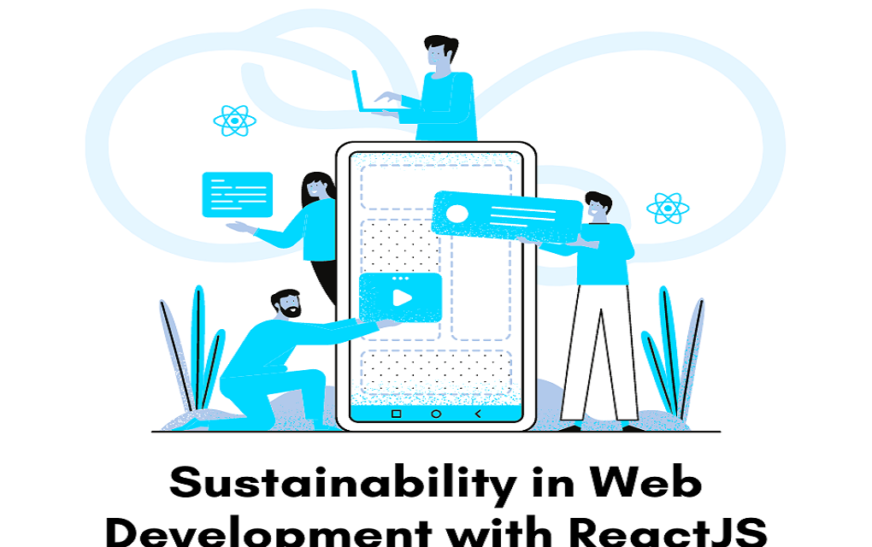Sustainable practices are in demand no two ways about it! Every small, large and medium sized business works wonders to create a greener future. There is a misconception that digital technology is clean since it doesn’t produce visible pollution like cars and factories. However one must know digital technology adds to carbon emissions, to an extent you could have never imagined. A figure equivalent to the output of the entire aviation industry.
Now as we all know the digital landscape stems from electricity usage and is highly sourced from fossil fuels. So when you burn these fossil fuels lots and lots of carbon dioxide (CO2) is produced which reduces the overall sustainability of the globe. No wonder for a few years sustainability has become a huge pressing concern among several industries and recognizing its impact on the planet is the first step to revolution and creating a greener online future.
The consumption and carbon footprint is skyrocketing every single time at this rate neglecting ecological considerations can be a huge mistake. As this can lead to excessive energy consumption, resource wastage and environmental degradation. So what to do? Well there is a way you can bring enough sustainability to web development with React. Wondering how? Keep reading the following post to know more.
Down below we would like to mention certain eco-conscious practices and thoughtful approaches so we can mitigate the environmental impact of websites while delivering exceptional user experiences.
The Importance of Sustainable Web Development
The internet seems to be evolving at a fanatic pace no two ways about it. With the increase in the number of websites the hunger for more exceptional digital content increases as well due to which traditional website design and development practices are no longer in vogue. This is great but it also means lots and lots of consumption and carbon footprint leading to excessive consumption, wastage of resources and environmental degradation. Here are certain negative impacts that the technology sector must ameliorate.
- Consumption of natural resources
- Electronic wastage
- Greenhouse gas emission
- Air and water pollution
Dangerous gases consisting of carbon dioxide, carbon monoxide, sulfur dioxide, nitric oxide and methane enter the earths surroundings which results in destructive outcomes and excessive destruction of the surroundings.
The Role of Developers in Creating Eco-Friendly Applications
Now it may quite interest you to know that any mobile application weighs 0.75 grams of CO2. The scope for green app development is gaining significance slowly and steadily. And let me tell you, highly functional, user friendly and environmentally friendly applications are developing.
Green app development mainly focuses on a wide range of fundamental principles for developing energy efficient and environmentally friendly applications. By doing so what are the consequences?
- Reducing energy consumption
- Using sustainable services
- Designing for longevity
- Energy-saving features
Well there are certain strategic approaches that developers need to consider:
- Reduce Code Bloat
- Optimizing Algorithms
- Improving data handling
- Memory management
- Energy-Aware Coding
- Renewable energy sources
- Energy efficiency
- Carbon offsetting
- Use the Dark Mode
- User-initiated content
- Optimized images and graphics
- User interface simplicity
- Efficient notifications
- Minimise background activity
- Updating regularly
- Energy Consumption Analysis
- Resource utilisation
- Automated Testing
- Real Device Testing
- Usage simulation
React’s Contribution to Sustainable Development
Now we all know that React is one of the leading Javascript libraries which is used to develop high end, robust and scalable user interfaces in addition to all this React is the most amazing and easy going technology when it comes to developing eco friendly web applications. Heres how
Efficient DOM Manipulation and Rendering
All required components are rendered and updated on a regular basis thanks to React’s virtual DOM and effective rendering approach. The total performance naturally improves as a result of the large reduction in needless re-renders.
React’s Component-Based Architecture for Reusability
Now another amazing advantage offered by React technology is that it offers component composition an amazing practice to combine different components to develop a more complicated UI. This is possible with the help of parent and child components.
In addition to component composition React assures reusability where the same component can be used in multiple places to get rid of code duplication and assure seamless consistency.
Component composition and reusability are the two fundamental concepts where React has an top hand over another available generation. Moreover it assures a greater exciting and effective improvement experience.
Performance Optimizations in React
There are a plethora of performance optimization techniques and strategies used while developing a sustainable application using React so that it responds instantly, uses resources effectively and enhances the productivity of the developers. Check the below mentioned list.
- Memoization with React.memo()
- Using useCallback() for Function Memoization
- Virtualization for Long Lists
- Code Splitting with React.lazy() and Suspense
- Optimizing Images and Assets
- Using Production Builds
- Avoiding Unnecessary State Updates
- Performance Profiling with React DevTools
Best Practices for Building Sustainable React Applications
It may additionally pretty interest you to realize that React became first used within the Facebook social networking feed and now it is one of the pinnacle technologies throughout the globe. Below are some first-class practices and techniques to recall for developing sustainable React Applications.
Minimizing Resource Usage through Lazy Loading
One of the most effective practices in React app development projects is lazy loading. And when you implement this practice it surely means your React app will grow seamlessly. Now this is the default procedure, React bundles and successfully deploys the entire application. So what can be done is it can be changed with the help of lazy loading or code splitting.
So here it is possible to limit a particular section of the app that gets loaded at a specific point. Splitting the bundles and simply loading according to the users requirements can save ample time and energy.
Code Splitting and Reducing Bundle Size
Another interesting way to consider this is code splitting. This feature is supported by bundlers like Webpack, Rollup and Browserify. Here it is about creating multiple bundles that can be dynamically loaded at runtime.
No website remains the same sooner or later it will grow and become heavy especially after including third party libraries. Code splitting indeed here comes to the rescue by generating multiple bundles that can run dramatically.
Optimizing Images Fonts and Other Assets
Another essential parameter to preserve tabs on for engaging in a sustainable net improvement assignment with React is photograph optimization. Slower sluggish packages are a big No-No. Here’s a tip do now not use images without delay within the code. Try compressing the images to reduce the file length and make sure that quality isn’t hindered at all. Tools together with imagemin or TinyPNG can be of top notch assist.
Leveraging Server-Side Rendering (SSR) and Static Site Generation (SSG)
Statically generated sites or pre rendering and server side rendered applications are some of the finest ways to develop front end applications. Well both of them are different but can often be mixed up as the same. For instance A static site generator is a software application used to develop HTML pages from templates and components. In other words website pages are generated at build time and the contents do not change unless there is not an addition or change. Some core benefits of using static generated sites include:
- Speed
- Deployment
- Security
- Version Control
Energy-Efficient Development with React
Energy consumption is a very crucial factor when considering sustainability and web development by tweaking some strategies can assure a reduction of energy usage. Here are some ways to optimise energy efficiency.
React and Lighthouse Audits for Performance and Sustainability
Now developing unique websites speed and user experience is no longer an afterthought. Now lighthouse audits are like an in store guide to analyse the performance and offer relevant recommendations especially when there is an insane leg for improvement. This is an automated open source tool to improve the quality of web pages.
The tool audits pages for performance, accessibility and SEO. Whats more to ask for? Here you also get relevant suggestions for improving any webpage. All the key metrics and actionable insights are considered for better user experiences.
Optimising React for Low-Power Devices and Mobile Users
Sluggish sites often cause bad user experience which can hurt your brand reputation and that’s the reason why performance optimization matters. Here are some crucial performance optimization techniques to look into.
- List Virtualization
- Essential coordination for rendering lists
- Using production build
- Javascript Event Action Throttling and Debouncing
- Functional elements and interaction
- Server-side rendering
- Using Prop-Types
Creating a Minimalist User-Friendly Design for Less Resource Intensive Apps
Lastly it is very important to develop resource intensive apps. Today with the evolving technological advancements the scope for inefficient coding and resource intensive technologies has significantly reduced. Moreover several reputable web development companies assure to perform only sustainable web development practices for greener culture and sustainability.
In all sustainable web development with React is a rising trend and there are a few key developments that will shine or shape the future.
- Green Hosting and Data Centers – Hosting providers and data centers are more likely to rise with the usage of solar and wind energy, efficient cooling systems and carbon offsetting.
- Using sustainable development frameworks and tools – Frameworks and tools are developed keeping sustainable web development in mind. So streamlined coding, resource optimization, energy efficient rendering and an easy development process are all perks available.
- AI-driven energy optimization – Disruptive technologies such as artificial intelligence are found to play a significant role in optimizing energy efficiency, automating image compression and dynamically adjusting website performance to maintain optimal user experience.
Case Studies: Sustainable Web Projects Using React
Of course there are some real life examples worth taking into account.
- The World Wildlife Fund (WWF) – This website is hosted on servers powered by renewable energy which means in simple words the website’s energy doesn’t contribute to any kind of climate change. This company uses much less resource intensive technologies which significantly reduces the amount of CPU and memory used.
- Orbus Software – This is an enterprise architecture platform company. It includes the dark mode in the header of every page so it is not just sustainable but also enhances user experience especially in the low lighting conditions and less energy scenarios.
- Clearstone Energy – This is a renewable energy company that offers a rare combination of sleek design and sustainable practices. So here you are bound to find clean energy solutions with optimized imagery and an intuitive user interface.
Conclusion
Sustainable web development won’t be established in a single day. It will take time but once installed can cause a huge variety of benefits and blessings together with reduced fees, greater efficiency, much less amount of wastage, unique use of resources and a lot more.
Key Takeaways:
- The hosting provider must use renewable energy sources
- Try optimizing the website performance to reduce carbon emissions
- Save time and resources by reusing and repurposing code
- Use open-source software and technologies such as Reactjs.
- Promote sustainability and adopt eco-friendly practices












